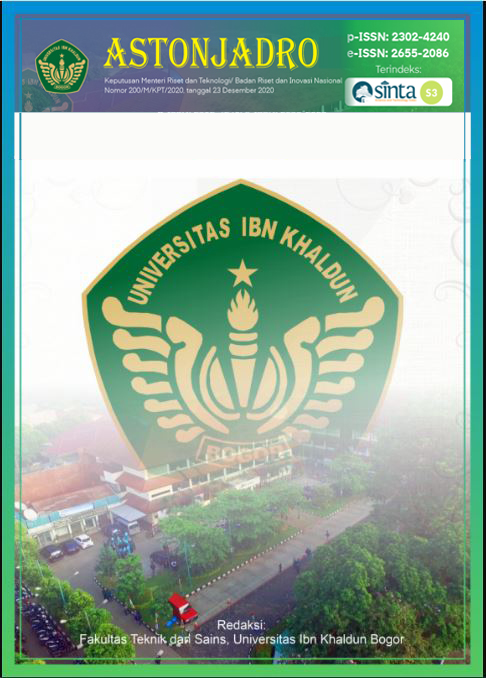Analysis of the Influence of Additional Plastic Waste (HDPE) as Mixed Asphalt AC-WC on Marshall Parameters
DOI:
https://doi.org/10.32832/astonjadro.v11i3.7507Keywords:
asphalt concrete wearing course (AC-WC), high density polyethylene (HDPE), marshall parameters.Abstract
Flexible pavement structures that use asphalt as a binder are currently the mainstay of the Indonesian people because of their large load-bearing capacity and economical construction costs. One type of flexible pavement used is asphalt concrete with the top surface layer or Asphalt Concrete Wearing Course (AC-WC). The use of asphalt from the petroleum refining process is one of the problems because its availability is decreasing. However, the condition of the road pavement which has a limited life requires periodic repairs to maintain the condition of the road. In addition, there are also problems regarding the processing of plastic waste which is still not optimal. Based on data published by the National Waste Management Information System in 2020 as much as 18.3% of the total waste generated. This figure increased by 2.3% from the previous year. Sukoharjo Regency also experienced an increase in sales of plastic waste by 1.16% from 14.04% (in 2019) and now to 15.20% (in 2020). Plastic is one type of polymer in the thermoplastic polymer group which is processed by organic chemical compounds. One type of plastic that is often used is High Density Polyethylene (HDPE) which has strong, light and flexible properties that can soften at a temperature of 130-137"℃" and harden again if. In this study, HDPE plastic bag waste was used as a pure asphalt substitute with variations in the proportion of substitution of 2%, 4%, 6%, 8%, 10%. Where this study aims to analyze the effect of adding HDPE plastic waste as a mixture of AC-WC asphalt on asphalt parameters. From the research conducted, the use of asphalt content of choice is 5.7%. With the results of the mixture with HDPE asphalt mixture HDPE has increased with the addition of variations of HDPE. The flexibility of HDPE asphalt mixture decreased according to the flow meter reading. At a content of 2% HDPE has the largest percentage of VIM, flow, and proportion of VMA, but has the lowest value and percentage of VFB. The best range of HDPE content is in the percentage of 4%-6% because it can increase the value of a more flexible mixture and optimal asphalt absorption. The use of HDPE plastic waste is an alternative in waste treatment and can reduce the use of asphalt. It can be concluded that HDPE plastic bags can be used as an alternative to bitumen substitutes that meet the requirements of Bina Marga 2018 Revised 2nd Edition.
References
Bambang Admadi, I. W. (2015). Teknologi Polimer. Universitas Udayana.
Bonner, D. (2001). Bituminous Materials. In Construction Materials (pp. 227-265). New York: Spon Press.
Direktorat Jenderal Bina Marga. (2020). Spesifikasi Umum 2018 Untuk Pekerjaan Konstruksi Jalan dan Jembatan (Revisi 2).(No 16.1/SE/Db/2020). Direktorat Jenderal Bina Marga,. Jakarta.
E Bachtiar, A Setiawan, F Musahir. (2022). High Strength Concrete Using Fly Ash A Cement And Fine Aggregate. ASTONJADRO: CEAESJ 11 (2), 448-457.
Hadid, M. (2020). Alternatif Aspal Modifikasi Polimer dengan Menggunakan Sampah Plastik Kemasan Makanan. Jurnal Manajemen Aset Infrastruktur & Fasilitas, IV, 43-52.
Hendra, O. (2021). Pengaruh Limbah Sampah Type HDPE (High Density Polyethylene) Pada Lapisan Aspal AC-WC. Jurnal Rekayasa Teknik Sipil Universitas Madura, 15-20.
Indra Mawardi, H. L. (2019). Proses Manufaktur Plastik dan Komposit (Edisi Revisi ed.). Yogyakarta: ANDI.
Johannes E. Simangunsong, M. J. (2021). Pemanfaatan Limbah Plastik PET Sebagai Bahan Tambah Aspal Pada Campuran Asphalt Concrete Wearing Course (AC-WC). Jurnal Teknologi, 26-33.
Kofteci, S. (2016). Effect of HDPE Based Wastes on the Performance of Modified Asphalt Mixtures. Procedia Engineering, 1268-1274.
Rahmawati, A. (2015). Pengaruh Penggunaan Plastik Polyethylene (PE) dan High Density Polyethylene (HDPE) Pada Campuran Lataston-WC Terhaap Karakteristik Marshall. Jurnal Ilmiah Semesta Teknika, 147-159.
R Rulhendri, N Chayati, S Syaiful. (2013). Kajian Tentang Penambahan Serat Terhadap Kuat Tekan Beton. ASTONJADRO: CEAESJ 2 (2), 44-48.
S Sutarno, D Rahmawati, H Masvika. (2021). Effect Of Chicken Feather Waste On Concrete Mixing On Compressive Strength And Flexural Strength. ASTONJADRO: CEAESJ 10 (1), 162-172
SA Nugroho, F Fatnanta, MF Alridho. (2021). Effect Of Adding Wood Powder Ash On Cbr Value In Stabilized High Plasticity Clay Cement And Lime. ASTONJADRO: CEAESJ 10 (2), 301-307.
Sukirman, S. (2016). Beton Aspal Campuran Panas. Bandung: Institut Teknologi Nasional.
YA Priastiwi, A Hidayat, R Tamrin, DB Sendrika. (2021). Resistance Of Mortar With PPC Cement And Geopolymer Mortar With White Soil Substitution In H2so4 Immersion. ASTONJADRO: CEAESJ 10 (2), 213-224.
Downloads
Published
How to Cite
Issue
Section
License
Copyright (c) 2022 ASTONJADRO: CEAESJ

This work is licensed under a Creative Commons Attribution-ShareAlike 4.0 International License.
Paper submitted to ASTONJADRO is the sole property of the Astonjadro Journal. Unless the author withdraws the paper because he does not want to be published in this journal. The publication rights are in the journal Astonjadro.ASTONJADRO
LICENSE
This work is licensed under a Creative Commons Attribution-ShareAlike 4.0 International License.
Based on a work at http://ejournal.uika-bogor.ac.id/index.php/ASTONJADRO













